Oasis Irrigation-Induced Hydro-Climatic Effects: A Case Study in the Hyper-Arid Region of Northwest China
Abstract
:1. Introduction
2. Materials and Methods
2.1. Study Area and Data
2.2. Categorization of Meteorological Stations
2.3. Estimation of ET0
2.4. Statistical Analysis
3. Results
3.1. Hydro-Climatic Characteristics
3.2. Spatial Distribution of ET0 Trends
3.3. Irrigation-Induced ET0 Effect
3.4. Irrigation-Induced Climatic Effect
4. Discussion
5. Conclusions and Uncertainty
Acknowledgments
Author Contributions
Conflicts of Interest
References
- Foley, J.A.; DeFries, R.; Asner, G.P.; Barford, C.; Bonan, G.; Carpenter, S.R.; Chapin, F.S.; Coe, M.T.; Daily, G.C.; Gibbs, H.K.; et al. Global consequences of land use. Science 2005, 309, 570–573. [Google Scholar] [CrossRef] [PubMed]
- Ellis, E.C.; Goldewijk, K.K.; Siebert, S.; Lightman, D.; Ramankutty, N. Anthropogenic transformation of the biomes, 1700 to 2000. Glob. Ecol. Biogeogr. 2010, 19, 589–606. [Google Scholar] [CrossRef]
- Kuchment, L.S. The hydrological cycle and human impact on it. In Water Resour. Manag(EOLSS), Developed under the Auspices of the UNESCO; Hoekstra, A.Y., Savenije, H.H.G., Eds.; Eolss Publishers: Oxford, UK, 2004. [Google Scholar]
- Christidis, N.; Stott, P.A.; Hegerl, G.C.; Betts, R.A. The role of land use change in the recent warming of daily extreme temperatures. Geophys. Res. Lett. 2013, 40, 589–594. [Google Scholar] [CrossRef] [Green Version]
- Ahn, K.H.; Merwade, V. Quantifying the relative impact of climate and human activities on streamflow. J. Hydrol. 2014, 515, 257–266. [Google Scholar] [CrossRef]
- Oliveraguerra, L.; Mattar, C.; Merlin, O.; Durán-Alarcón, C.; Santamaría-Artigas, A.; Fuster, R. An operational method for the disaggregation of land surface temperature to estimate actual evapotranspiration in the arid region of Chile. ISPRS J. Photogramm. Remote Sens. 2017, 128, 170–181. [Google Scholar] [CrossRef]
- Santos, C.A.G.; Silva, R.M.D.; Silva, A.M.; Neto, R.M.B. Estimation of evapotranspiration for different land covers in a Brazilian semi-arid region: A case study of the Brígida River basin, Brazil. J. S. Am. Earth Sci. 2017, 74, 54–66. [Google Scholar] [CrossRef]
- Huo, Z.; Dai, X.; Feng, S.; Kang, S.; Huang, G. Effect of climate change on reference evapotranspiration and aridity index in arid region of China. J. Hydrol. 2013, 492, 24–34. [Google Scholar] [CrossRef]
- Diffenbaugh, N.S. Influence of modern land cover on the climate of the United States. Clim. Dyn. 2009, 33, 945–958. [Google Scholar] [CrossRef]
- Mahmood, R.; Sr, R.A.P.; Hubbard, K.G.; Niyogi, D.; Dirmeyer, P.A.; McAlpine, C.; Carleton, A.M.; Hale, R.; Gameda, S. Land cover changes and their biogeophysical effects on climate. Int. J. Climatol. 2014, 34, 929–953. [Google Scholar] [CrossRef]
- Wang, K.; Dickinson, R.E. A review of global terrestrial evapotranspiration: Observation, modeling, climatology and climatic variability. Rev. Geophys. 2012, 50, RG2005. [Google Scholar] [CrossRef]
- Cannarozzo, M.; Noto, L.V.; Viola, F. Spatial distribution of rainfall trends in Sicily (1921–2000). Phys. Chem. Earth 2006, 31, 1201–1211. [Google Scholar] [CrossRef]
- Boucher, O.; Myhre, G.; Myhre, A. Direct human influence of irrigation on atmospheric water vapor and climate. Clim. Dyn. 2004, 22, 597–603. [Google Scholar] [CrossRef]
- Lobell, D.; Bala, G.; Mirin, A.; Phillips, T.; Maxwell, R.; Rotman, D. Regional differences in the influence of irrigation on climate. J. Clim. 2009, 22, 2248–2255. [Google Scholar] [CrossRef]
- Sr, R.A.P.; Pitman, A.; Niyogi, D.; Mahmood, R.; McAlpine, C.; Hossain, H.; Goldewijk, K.K.; Nair, U.; Betts, R.; Fall, S.; et al. Land use/land cover changes and climate: Modeling analysis and observational evidence. Wiley Interdiscip. Rev. Clim. Chang. 2011, 2, 828–850. [Google Scholar]
- Lei, H.M.; Yang, D.W.; Yang, H.B.; Yuan, Z.J.; Lv, H.F. Simulated impacts of irrigation on evapotranspiration in a strongly exploited region: A case study of the Haihe River basin, China. Hydrol. Process. 2014, 29, 2704–2719. [Google Scholar] [CrossRef]
- Bonfils, C.; Lobell, D. Empirical evidence for a recent slowdown in irrigation-induced cooling. Proc. Natl. Acad. Sci. USA 2007, 104, 13582–13587. [Google Scholar] [CrossRef] [PubMed]
- Matthews, H.D.; Weaver, A.J.; Eby, M.; Meissner, K.J. Radiative forcing of climate by historical land cover change. Geophys. Res. Lett. 2003, 30, 1055. [Google Scholar] [CrossRef]
- Matthews, H.D.; Weaver, A.J.; Meissner, K.J.; Gillett, N.P.; Eby, M. Natural and anthropogenic climate change: Incorporating historical land cover change, vegetation dynamics and the global carbon cycle. Clim. Dyn. 2004, 22, 461–479. [Google Scholar] [CrossRef]
- Kijne, J.W.; Barker, R.; Molden, D. Water Productivity in Agriculture: Limits and Opportunities for Improvement; CABI Publishing: Wallingford, UK, 2003; pp. 390–391. [Google Scholar]
- Wu, P.; Zhao, X. Impact of climate change on agricultural water use and grain production in China. Trans. Chin. Soc. Agric. Eng. 2010, 26, 1–6. [Google Scholar]
- Zhong, R.S.; Dong, X.G.; Ma, Y.J. Sustainable water saving: New concept of modern agricultural water saving, starting from development of Xinjiang’s agricultural irrigation over the last 50 years. Irrig. Drain. 2009, 58, 383–392. [Google Scholar]
- Siebert, S.; Doll, P.; Hoogeveen, J.; Faures, J.-M.; Frenken, K.; Feick, S. Development and validation of the global map of irrigation areas. Hydrol. Earth Syst. Sci. 2005, 9, 535–547. [Google Scholar] [CrossRef]
- Tong, L.; Kang, S.; Zhang, L. Temporal and spatial variations of evapotranspiration for spring wheat in the Shiyang River basin in Northwest China. Agric. Water Manag. 2007, 87, 241–250. [Google Scholar] [CrossRef]
- Wang, X.M.; Dong, Z.B.; Zhang, J.W.; Lium, L.C. Modern dust storms in China: An overview. J. Arid Environ. 2004, 58, 559–574. [Google Scholar] [CrossRef]
- Beringer, J. Ecological Climatology: Concepts and Applications, 2nd ed.; Bonan, G.B., Ed.; Cambridge University Press: New York, NY, USA, 2010; Volume 48, pp. 221–222. [Google Scholar]
- Koster, R.D.; Dirmeyer, P.A.; Guo, Z.C.; Bonan, G.; Chan, R.; Cox, P.; Gordon, C.T.; Kanae, S.; Kowalczyk, E.; Lawrence, D.; et al. Regions of strong coupling between soil moisture and precipitation. Science 2004, 305, 1138–1140. [Google Scholar] [CrossRef] [PubMed]
- Dai, A.; Trenberth, K.E.; Karl, T.R. Effects of clouds, soil moisture, precipitation and water vapor on diurnal temperature range. J. Clim. 1999, 12, 2451–2473. [Google Scholar] [CrossRef]
- Han, S.J.; Xu, D.; Wang, S.L. Decreasing potential evaporation trends in China from 1956 to 2005: Accelerated in regions with significant agricultural influence? Agric. For. Meteorol. 2012, 154–155, 44–56. [Google Scholar] [CrossRef]
- Feng, Z.; Liu, B.; Yang, Y. A study of the changing trend of Chinese cultivated land amount and data reconstructing: 1949–2003. J. Nat. Resour. 2005, 20, 35–43. [Google Scholar]
- Deng, M.J.; Wang, S.J.; Dong, X.G.; Zhang, S.M. Water Resources and Sustainable Utilization in Xinjiang Uygur Autonomous Region; China Water Power Press: Beijing, China, 2005. [Google Scholar]
- Dai, X.; Pu, L.; Rao, F. Assessing the Effect of a Crop-Tree Intercropping Program on Smallholders’ Incomes in Rural Xinjiang, China. Sustainability 2017, 9, 1542. [Google Scholar] [CrossRef]
- Allen, R.G. Evaluation of Procedures for Estimating Mean Monthly Solar Radiation from Air Temperature; United Nations Food and Agricultural Organization (FAO): Rome, Italy, 1995. [Google Scholar]
- Belward, A.S. The IGBP-DIS Global 1 km Land Cover Data Set ‘DISCover’ Proposal and Implementation Plans; Report of the Land Cover Working Group of IGBP-DIS; IGBP-DIS Working Paper #13; IGBP Data and Information System Office: Toulouse, France, 1996; pp. 11–19. [Google Scholar]
- Rim, C.S. The effects of urbanization, geographical and topographical conditions on reference evapotranspiration. Clim. Chang. 2009, 97, 483–514. [Google Scholar] [CrossRef]
- Lobell, D.B.; Bonfils, C. The effect of irrigation on regional temperatures: A spatial and temporal analysis of trends in California, 1934–2002. J. Clim. 2008, 21, 2063–2071. [Google Scholar] [CrossRef]
- Allen, R.G.; Periera, L.S.; Raes, D.; Smith, M. Crop Evapotranspiration: Guideline for Computing Crop Water Requirement; FAO Irrigation and Drainage Paper No. 56; United Nations Food and Agricultural Organization (FAO): Rome, Italy, 1998. [Google Scholar]
- Hargreaves, G.H.; Samani, Z.A. Estimating potential evapotranspiration. J. Irrig. Drain. Div. 1982, 108, 223–230. [Google Scholar]
- Mann, H.B. Non-parametric tests against trend. Econometrica 1945, 13, 245–259. [Google Scholar] [CrossRef]
- Kendall, M.G. Rank Correlation Method, 4th ed.; Charles Griffin: London, UK, 1975. [Google Scholar]
- Sen, P.K. Estimates of the regression coefficients based on Kendall’s tau. J. Am. Stat. Assoc. 1968, 63, 1379–1389. [Google Scholar] [CrossRef]
- Salmi, T.; Maatta, A.; Anttila, P.; Ruoho-Airola, T.; Amnell, T. Detecting Trends of Annual Values of Atmospheric Pollutants by the Mann-Kendall Test and Sen’s Slope Estimates—The Excel Template Application MAKESENS; Finnish Meteorological Institute: Helsinki, Finland, 2002. [Google Scholar]
- Dinpashoh, Y.; Jhajharia, D.; Fakheri-Fard, A.; Singh, V.P.; Kahya, E. Trends in reference crop evapotranspiration over Iran. J. Hydrol. 2011, 399, 422–433. [Google Scholar] [CrossRef]
- Jhajharia, D.; Dinpahoh, Y.; Kahya, E.; Singh, V.P.; Fakheri-Fard, A. Trends in reference evapotranspiration in the humid region of North East India. Hydrol. Process. 2011, 26, 421–435. [Google Scholar] [CrossRef]
- Yue, S.; Pilon, P.; Phinney, B.; Cavadias, G. The influence of autocorrelation on the ability to detect trend in hydrological series. Hydrol. Process. 2002, 16, 1807–1829. [Google Scholar] [CrossRef]
- Zhang, Y.; Liu, C.; Tang, Y.; Yang, Y. Trends in pan evaporation and reference and actual evapotranspiration across the Tibetan Plateau. J. Geophys. Res. Atmos. 2007, 112, 113–120. [Google Scholar] [CrossRef]
- Liu, Q.; Yang, Z.; Cui, B.; Sun, T. The temporal trends of reference evapotranspiration and its sensitivity to key meteorological variables in the Yellow River basin, China. Hydrol. Process. 2010, 24, 2171–2181. [Google Scholar] [CrossRef]
- Xing, W.; Wang, W.G.; Shao, Q.X.; Peng, S.X.; Yu, Z.B.; Yong, B.; Taylor, J. Changes of reference evapotranspiration in the Haihe River Basin: Present observations and future projection from climatic variables through multi-model ensemble. Glob. Planet. Chang. 2014, 115, 1–15. [Google Scholar] [CrossRef]
- Zhang, X.; Tang, Q.; Zheng, J.; Ge, Q. Warming/cooling effects of cropland greenness changes during 1982–2006 in the North China Plain. Environ. Res. Lett. 2013, 8, 24–38. [Google Scholar] [CrossRef]
- Ozdogan, M.; Salvucci, G.D.; Anderson, B.T. Examination of the Bouchet Morton complementary relationship using a mesoscale climate model and observations under a progressive irrigation scenario. J. Hydrometeorol. 2006, 7, 235–251. [Google Scholar] [CrossRef]
- Intergovernmental Panel on Climate Change, Summary for Policymakers. Climate Change 2007: The Physical Science Basis; Contribution of Working Group I to the Fourth Assessment Report of the Intergovernmental Panel on Climate Change; Cambridge University Press: New York, NY, USA, 2007. [Google Scholar]
- Cook, B.I.; Puma, M.J.; Krakauer, N.Y. Irrigation induced surface cooling in the context of modern and increased greenhouse gas forcing. Clim. Dyn. 2011, 37, 1587–1600. [Google Scholar] [CrossRef]
- Najafi, M.R.; Zwiers, F.W.; Gillett, N.P. Attribution of Arctic temperature change to greenhouse-gas and aerosol influences. Nat. Clim. Chang. 2015, 5, 246–249. [Google Scholar] [CrossRef]
- Xu, L.H.; Shi, Z.J.; Wang, Y.H.; Zhang, D.L.; Chu, X.Z.; Yu, P.T.; Xiong, W.; Zuo, H.J.; Wang, Y.N. Spatiotemporal variation and driving forces of reference evapotranspiration in Jing River Basin, northwest China. Hydrol. Process. 2015, 29, 4846–4862. [Google Scholar] [CrossRef]
- Adegoke, J.O.; Pielke, R.A.; Eastman, J.; Mahmood, R.; Hubbard, K.G. Impact of irrigation on midsummer surface fluxes and temperature under dry synoptic conditions: A regional atmospheric model study of the U.S. high plains. Mon. Weather Rev. 2003, 131, 556–564. [Google Scholar] [CrossRef]
- Mahmood, R.; Hubbard, K.G.; Carlson, C. Modification of growing-season surface temperature records in the northern Great Plains due to land-use transformation: Verification of modelling results and implication for global climate change. Int. J. Climatol. 2004, 24, 311–327. [Google Scholar] [CrossRef]
- Lobell, D.B.; Bala, G.; Duffy, P.B. Biogeophysical impacts of cropland management changes on climate. Geophys. Res. Lett. 2006, 33, L06708. [Google Scholar] [CrossRef]
- Williams, K.R.S. Correlation between Palmer drought indices and various measures of air temperature in the climatic zones of the United States. Phys. Geogr. 1992, 13, 349–367. [Google Scholar]
- Vautard, R.; Cattiaux, J.; Yiou, P.; Thepau, J.N.; Ciais, P. Northern Hemisphere atmospheric stilling partly attributed to an increase in surface roughness. Nat. Geosci. 2010, 3, 756–761. [Google Scholar] [CrossRef]
- Roderick, M.L.; Farquhar, G.D. The cause of decreased pan evaporation over the past 50 years. Science 2002, 298, 1410–1411. [Google Scholar] [PubMed]
- Stanhill, G.; Cohen, S. Global dimming: A review of the evidence for a widespread and significant reduction in global radiation with discussion of its probable causes and possible agricultural consequences. Agric. For. Meteorol. 2001, 107, 255–278. [Google Scholar] [CrossRef]
- Han, S.J.; Tang, Q.H.; Xu, D.; Wang, S.L. Irrigation-induced changes in potential evaporation: More attention is needed. Hydrol. Process. 2014, 28, 2717–2720. [Google Scholar] [CrossRef]
- Wang, S.D.; Wang, Y.G.; Wang, J.; Mao, W.Y.; Shen, Y.P. Change of climate and hydrology in the Tarim River Basin during past 40 years and their impact. J. Glaciol. Geocryol. 2003, 25, 315–320. [Google Scholar]
- Wang, Y.B.; Chen, Y.N. Impact of population growth and land-use change on water resources and ecosystems of the arid Tarim River Basin in Western China. Int. J. Sustain. Dev. World Ecol. 2006, 13, 295–305. [Google Scholar]
- Bai, Y.; Xu, H.L.; Ling, H.B. Drought-flood variation and its correlation with runoff in three headstreams of Tarim River, Xingjiang, China. Environ. Earth Sci. 2014, 71, 1297–1309. [Google Scholar] [CrossRef]
- Ye, Z.X.; Chen, Y.N.; Zhang, X. Dynamics of runoff, river sediments and climate change in the upper reaches of the Tarim River, China. Quat. Int. 2014, 26, 13–19. [Google Scholar] [CrossRef]
- Brutsaert&Amp, W.; Parlange, M.B. Hydrologic cycle explains the evaporation paradox. Nature 1998, 396, 30. [Google Scholar]
- Brown, A.E.; Zhang, L.; McMahon, T.A.; Western, A.W.; Vertessy, R.A. A review of paired catchment studies for determining changes in water yield resulting from alterations in vegetation. J. Hydrol. 2005, 310, 28–61. [Google Scholar] [CrossRef]
- Li, H.Y.; Liu, X.H.; Kejia, D.; Zhou, Q.; Ma, T.; Gao, Y. Ecological restoration and its effects on a regional Climate: The Source Region of the Yellow River, China. Environ. Sci. Technol. 2015, 49, 5897–5904. [Google Scholar] [CrossRef] [PubMed]
- Gordon, L.J.; Steffen, W.; Jonsson, B.F.; Folke, C.; Falkenmark, M.; Johannessen, Å. Human modification of global water vapor € flows from the land surface. Proc. Natl. Acad. Sci. USA 2005, 102, 7612–7617. [Google Scholar] [CrossRef] [PubMed]
- Sorooshian, S.; Li, J.; Hsu, K.L.; Guo, X.G. Influence of irrigation schemes used in regional climate models on evapotranspiration estimation: Results and comparative studies from California’s Central Valley agricultural regions. J. Geophys. Res. 2012, 117, 6107. [Google Scholar] [CrossRef]
- Lo, M.H.; Famiglietti, J.S. Irrigation in California’s Central Valley strengthens the southwestern US water cycle. Geophys. Res. Lett. 2013, 40, 301–306. [Google Scholar] [CrossRef]
- Leng, G.; Huang, M.; Tang, Q.; Leung, L.R. A modeling study of irrigation effects on global surface water and groundwater resources under a changing climate. J. Adv. Model. Earth Syst. 2015, 7, 1285–1304. [Google Scholar] [CrossRef]
- Nazemi, A.; Wheater, H.S. On inclusion of water resource management in Earth system models—Part 1: Problem definition and representation of water demand. Hydrol. Earth Syst. Sci. 2015, 19, 63–90. [Google Scholar] [CrossRef]
- Leng, G.; Leung, L.R.; Huang, M. Significant impacts of irrigation water sources and methods on modeling irrigation effects in the ACME Land Model. J. Adv. Model. Earth Syst. 2017. [Google Scholar] [CrossRef]


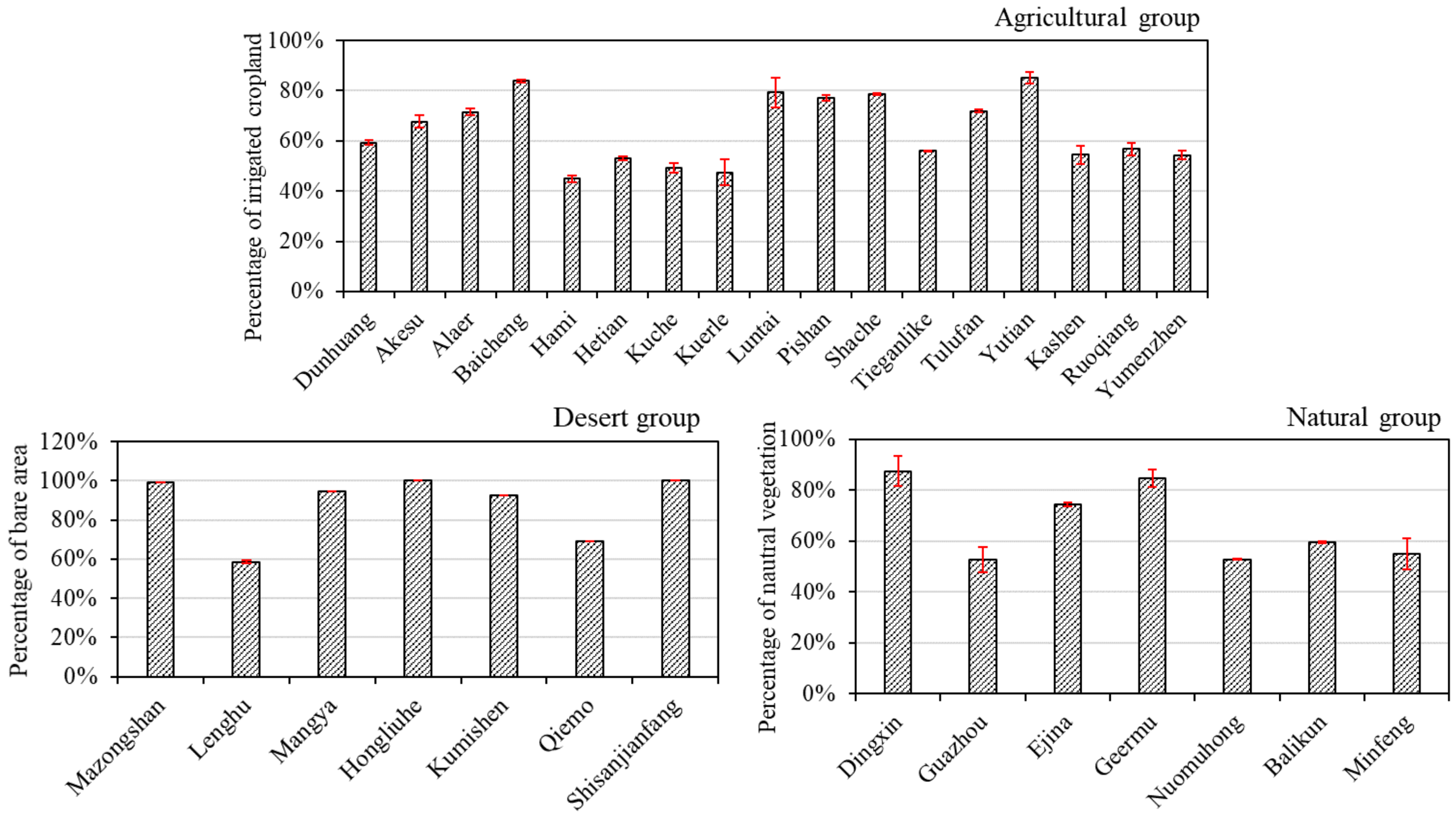
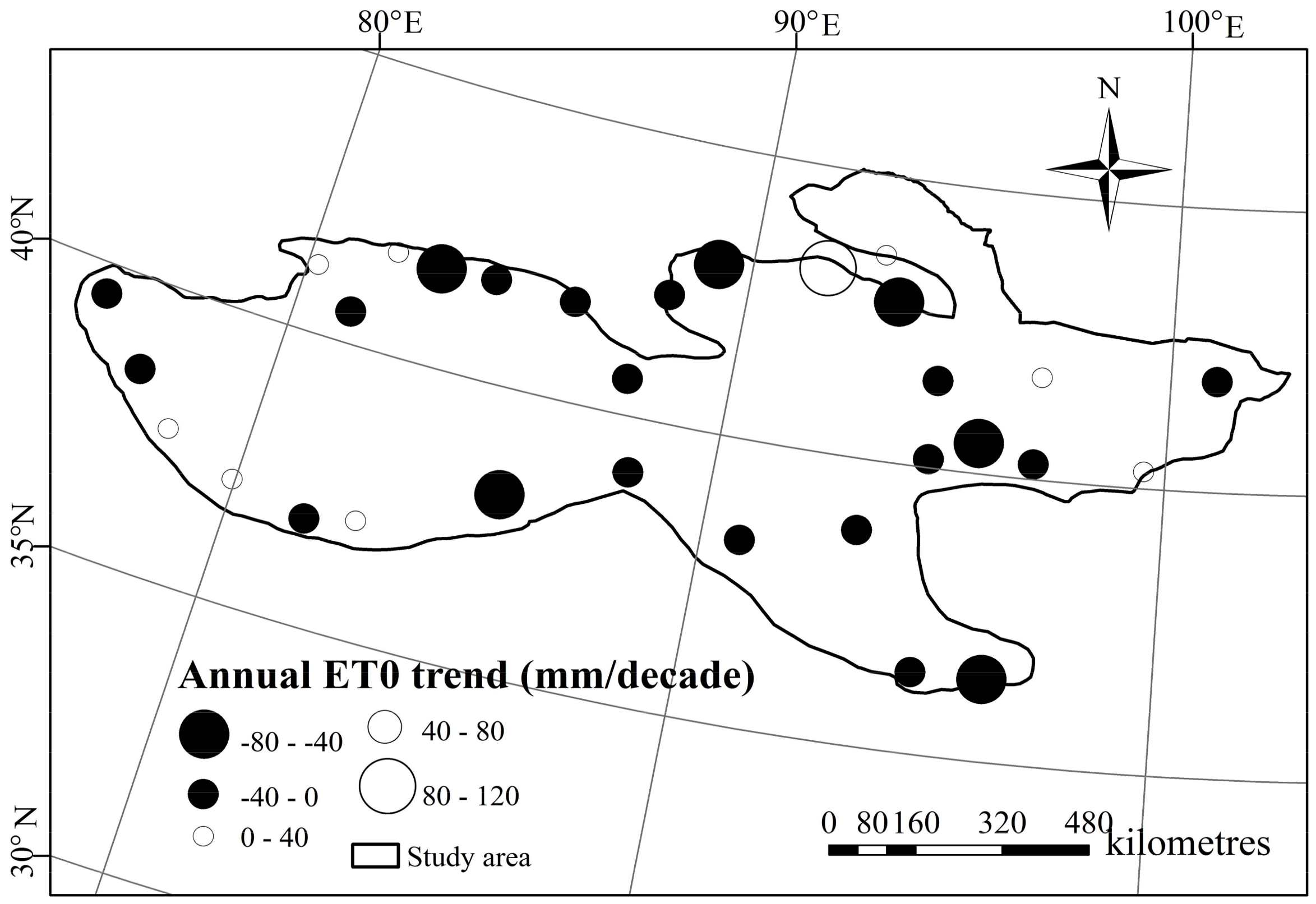
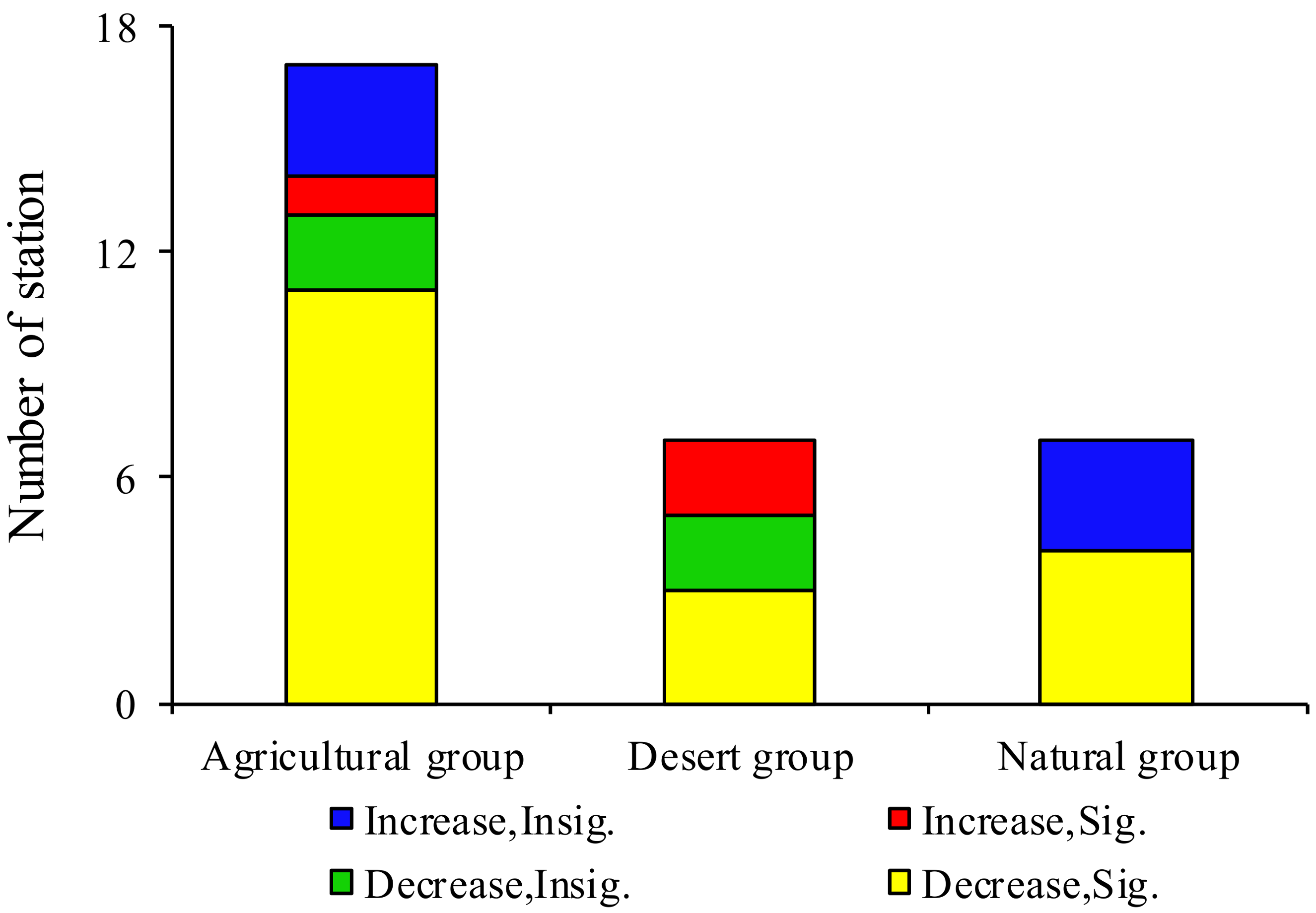
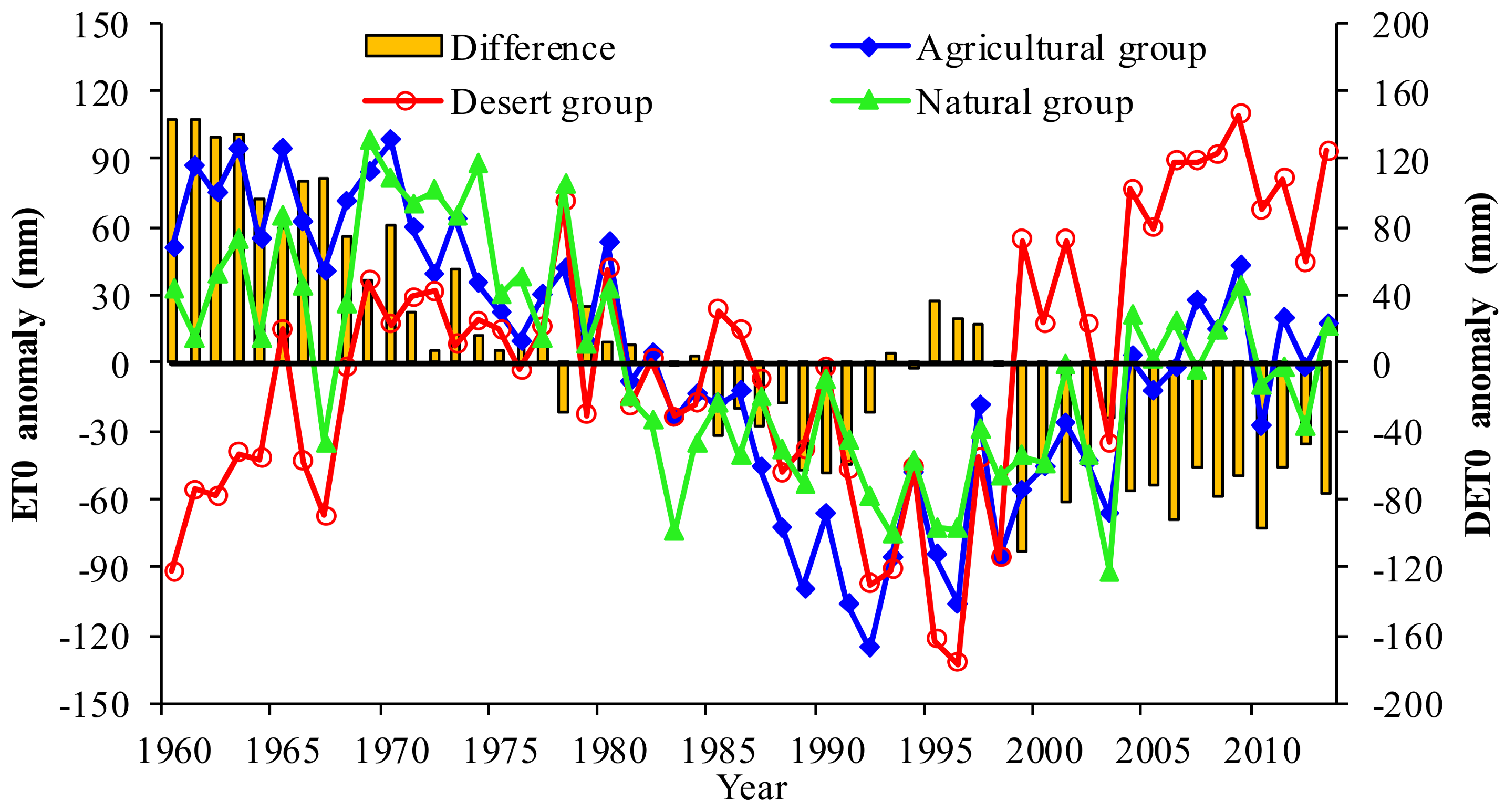
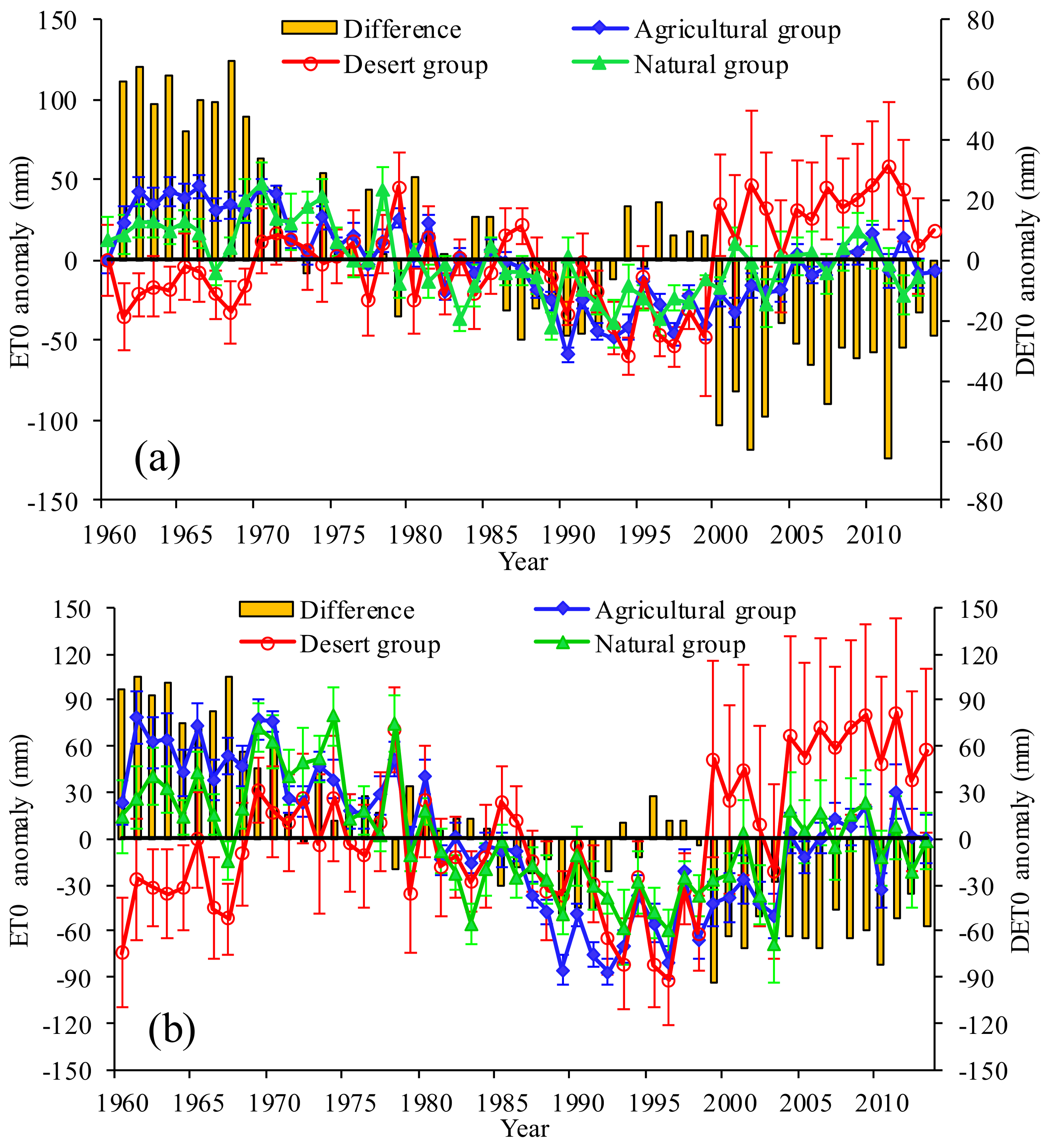

| Radius (km) | Cultivated Land | Bare Land | ||
|---|---|---|---|---|
| Annual | Growing Season | Annual | Growing Season | |
| 1 | −0.35 * | −0.36 * | 0 | 0 |
| 2 | −0.33 * | −0.35 * | 0 | 0 |
| 3 | −0.35 * | −0.37 ** | 0.36 ** | 0.37 ** |
| 4 | −0.36 ** | −0.37 ** | 0.38 ** | 0.39 ** |
| 5 | −0.31 * | −0.32 * | 0.35 * | 0.35 * |
| 6 | −0.31 * | −0.32 * | 0.33 * | 0.34 * |
| 7 | −0.31 * | −0.32 * | 0.33 * | 0.33 * |
| 8 | −0.28 | −0.30 | 0.31 * | 0.32 * |
| 9 | −0.27 | −0.29 | 0.31 * | 0.31 * |
| 10 | −0.26 | −0.27 | 0.31 * | 0.31 * |
| 15 | −0.21 | −0.23 | 0.30 | 0.30 * |
| 20 | −0.17 | −0.19 | 0.28 | 0.29 |
| 25 | −0.14 | −0.16 | 0.27 | 0.27 |
| 30 | −0.12 | −0.14 | 0.27 | 0.27 |
| Group | Number of Stations | Land Use Ratio | ET0 (mm) | Tmax (°C) | Tmin (°C) | RH (%) | WS (m/s) | N (h/a) | P (mm) | Altitude (m) | ||
|---|---|---|---|---|---|---|---|---|---|---|---|---|
| Bare Land | Cropland | Natural Vegetation | ||||||||||
| Agricultural group | 17 | 0.07 | 0.60 | 0.33 | 1180.9 | 12.6 | 4.4 | 47.2 | 1.9 | 2922.2 | 54.6 | 1070.50 |
| Desert group | 7 | 0.94 | 0.04 | 0.02 | 1405.4 | 10.2 | −0.8 | 36.3 | 3.8 | 3230.6 | 42.3 | 1244.04 |
| Natural group | 7 | 0.21 | 0.15 | 0.64 | 1246.4 | 13.0 | 0.1 | 40.2 | 2.7 | 3167.6 | 69.6 | 1275.10 |
| Type | Average Trend Magnitude (mm/Decade) | |||||
|---|---|---|---|---|---|---|
| Annual | Growing Season | Spring | Summer | Autumn | Winter | |
| Agricultural group | −24.55 ± 2.51 | −18.50 ± 1.95 | −5.91 ± 0.77 | −10.81 ± 1.11 | −5.40 ± 0.55 | −0.80 ± 0.23 |
| Desert group | 9.10 ± 6.62 | 7.06 ± 4.55 | 3.56 ± 1.75 | 4.58 ± 2.63 | 1.17 ± 1.54 | 0.12 ± 0.43 |
| Natural group | −16.25 ± 2.34 | −12.00 ± 1.81 | −3.04 ± 0.63 | −7.24 ± 1.10 | −4.30 ± 0.57 | −0.80 ± 0.16 |
| All stations | −20.06 ± 2.53 | −14.78 ± 1.95 | −4.51 ± 0.76 | −8.70 ± 1.12 | −4.87 ± 0.58 | −0.89 ± 0.22 |
| Difference | −33.65 | −25.56 | −9.47 | −15.39 | −6.57 | −0.92 |
| Period | Agricultural Group | Desert Group | Natural Group | Difference |
|---|---|---|---|---|
| 1960–1970 | 10.90 | 92.85 | 36.15 | −81.95 |
| 1970–1992 | −80.38 | −34.46 | −64.21 | −45.92 |
| 1992–2013 | 59.53 | 103.72 | 39.85 | −44.19 |
| 1960–2013 | −21.88 | 14.92 | −15.02 | −36.80 |
| Timescale | Station Groups | Tmax (°C/Decade) | Tmin (°C/Decade) | RH (%/Decade) | WS (m/s/Decade) | N (h/a/Decade) | P (mm/Decade) |
|---|---|---|---|---|---|---|---|
| Annual | Agricultural group | 0.25 ± 0.01 | 0.38 ± 0.03 | 0.30 ± 0.09 | −0.16 ± 0.01 | −6.27 ± 4.89 | 3.76 ± 0.30 |
| Desert group | 0.41 ± 0.02 | 0.56 ± 0.03 | 0.06 ± 0.07 | −0.09 ± 0.03 | −19.95 ± 4.99 | 0.76 ± 0.28 | |
| Natural group | 0.38 ± 0.01 | 0.64 ± 0.03 | −0.4 ± 0.08 | −0.21 ± 0.02 | −14.79 ± 2.53 | 3.22 ± 0.26 | |
| Difference | −0.16 | −0.18 | 0.24 | −0.07 | 13.68 | 3.00 | |
| Growing season | Agricultural group | 0.19 ± 0.02 | 0.33 ± 0.03 | 0.37 ± 0.11 | −0.19 ± 0.01 | 6.16 ± 2.75 | 2.87 ± 0.29 |
| Desert group | 0.40 ± 0.02 | 0.57 ± 0.03 | −0.10 ± 0.09 | −0.06 ± 0.03 | −11.39 ± 2.99 | 0.16 ± 0.31 | |
| Natural group | 0.36 ± 0.02 | 0.59 ± 0.03 | −0.59 ± 0.08 | −0.23 ± 0.02 | −10.20 ± 2.33 | 2.54 ± 0.26 | |
| Difference | −0.21 | −0.24 | 0.47 | −0.13 | 17.55 | 2.71 | |
| Spring | Agricultural group | 0.22 ± 0.01 | 0.39 ± 0.03 | −0.37 ± 0.08 | −0.20 ± 0.01 | 10.31 ± 1.53 | 0.31 ± 0.04 |
| Desert group | 0.31 ± 0.02 | 0.50 ± 0.03 | −0.23 ± 0.07 | −0.06 ± 0.03 | 3.46 ± 14.59 | 0.25 ± 0.49 | |
| Natural group | 0.30 ± 0.02 | 0.54 ± 0.03 | −0.76 ± 0.08 | −0.23 ± 0.03 | 2.67 ± 10.63 | 0.84 ± 0.09 | |
| Difference | −0.09 | −0.11 | 0.14 | −0.07 | 6.85 | 0.06 | |
| Summer | Agricultural group | 0.15 ± 0.02 | 0.31 ± 0.03 | 0.53 ± 0.12 | −0.18 ± 0.01 | −2.59 ± 1.43 | 2.02 ± 0.18 |
| Desert group | 0.40 ± 0.02 | 0.62 ± 0.03 | −0.19 ± 0.09 | −0.05 ± 0.03 | −11.93 ± 1.65 | −0.39 ± 0.19 | |
| Natural group | 0.36 ± 0.02 | 0.62 ± 0.03 | −0.54 ± 0.09 | −0.22 ± 0.03 | −8.97 ± 1.34 | 1.66 ± 0.19 | |
| Difference | −0.25 | −0.31 | 0.72 | −0.13 | 9.34 | 2.41 | |
| Autumn | Agricultural group | 0.23 ± 0.02 | 0.32 ± 0.03 | 0.61 ± 0.14 | −0.13 ± 0.01 | −3.65 ± 0.96 | 0.69 ± 0.10 |
| Desert group | 0.45 ± 0.02 | 0.62 ± 0.03 | 0.31 ± 0.10 | −0.07 ± 0.02 | −5.47 ± 1.13 | −0.07 ± 0.10 | |
| Natural group | 0.41 ± 0.02 | 0.65 ± 0.03 | −0.31 ± 0.10 | −0.20 ± 0.03 | −3.98 ± 0.86 | 0.35 ± 0.09 | |
| Difference | −0.22 | −0.30 | 0.30 | −0.06 | 1.82 | 0.76 | |
| Winter | Agricultural group | 0.31 ± 0.02 | 0.49 ± 0.03 | 0.47 ± 0.09 | −0.11 ± 0.01 | −7.33 ± 1.45 | 0.67 ± 0.07 |
| Desert group | 0.40 ± 0.02 | 0.58 ± 0.04 | 0.35 ± 0.07 | −0.11 ± 0.03 | −4.22 ± 1.55 | 1.14 ± 0.15 | |
| Natural group | 0.35 ± 0.02 | 0.76 ± 0.04 | 0.05 ± 0.08 | −0.19 ± 0.02 | −3.67 ± 1.10 | 0.23 ± 0.15 | |
| Difference | −0.09 | −0.09 | 0.12 | 0.00 | −3.11 | −0.47 |
© 2018 by the authors. Licensee MDPI, Basel, Switzerland. This article is an open access article distributed under the terms and conditions of the Creative Commons Attribution (CC BY) license (http://creativecommons.org/licenses/by/4.0/).
Share and Cite
Shan, N.; Shi, Z.; Yang, X.; Guo, H.; Zhang, X.; Zhang, Z. Oasis Irrigation-Induced Hydro-Climatic Effects: A Case Study in the Hyper-Arid Region of Northwest China. Atmosphere 2018, 9, 142. https://doi.org/10.3390/atmos9040142
Shan N, Shi Z, Yang X, Guo H, Zhang X, Zhang Z. Oasis Irrigation-Induced Hydro-Climatic Effects: A Case Study in the Hyper-Arid Region of Northwest China. Atmosphere. 2018; 9(4):142. https://doi.org/10.3390/atmos9040142
Chicago/Turabian StyleShan, Nan, Zhongjie Shi, Xiaohui Yang, Hao Guo, Xiao Zhang, and Zhiyong Zhang. 2018. "Oasis Irrigation-Induced Hydro-Climatic Effects: A Case Study in the Hyper-Arid Region of Northwest China" Atmosphere 9, no. 4: 142. https://doi.org/10.3390/atmos9040142





